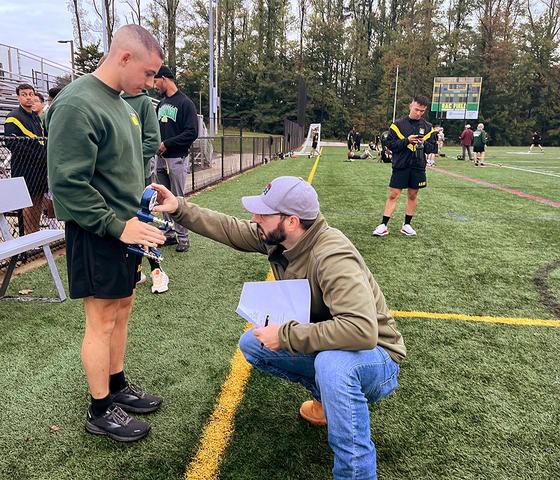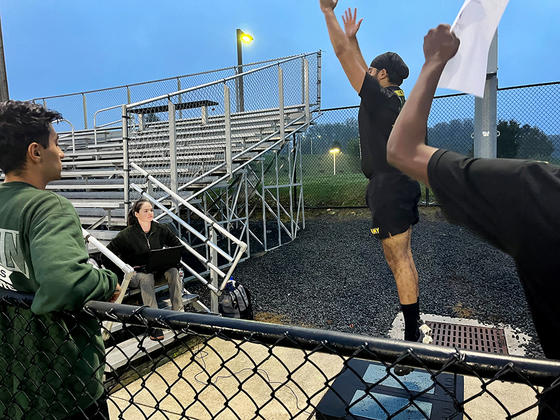From dietitians to personal trainers, it takes a team of experts and specialists to keep professional athletes strong and healthy throughout their careers. But Joel Martin, associate professor of kinesiology in George Mason University’s College of Education and Human Development, thinks there’s one group of athletes missing that same level of support: tactical athletes.

“Tactical athletes are those in professions where physical fitness is a critical component, but who aren’t sport athletes,” Martin explained. This includes military, law enforcement, and first responders. Through the Fit2Serve program, Martin hopes to give tactical athletes the support and resources they’re missing.
Fit2Serve began through an Office of Student Scholarship, Creative Activities, and Research (OSCAR) summer impact grant. Martin works with student researchers in Mason’s Sports Medicine Assessment Research and Testing (SMART) Lab on the SciTech Campus to provide fitness testing and wellness resources for tactical athletes and looks for solutions for their specific challenges.
“I think a lot of us know someone involved in military or emergency response,” Martin said, “and we don’t always appreciate the challenges those professions experience, both day-to-day and long term.”
Fitness, Martin said, is more than exercise—sleep, diet, mental wellness, and everyday physical activity all play a role. By improving overall fitness, Martin hopes to improve tactical athletes’ ability to complete occupational tasks and their health and longevity, as well as prevent injuries. For firefighters especially, there is a critical need for better resources, education, and research in these areas.
“Post-retirement mortality rates for firefighters are, on average, much higher than the rest of the population, due to the high physical demands of their jobs, high potential for injury, and consequences of poor sleep and wellness while on active duty,” Martin said. “We want to improve that statistic.”
His research team uses tools such as sleep surveys and real-time fitness monitoring during training exercises to make holistic recommendations for first responder wellness strategies.
“It’s useful for them to understand the physical demands of what they’re doing in order to make more informed decisions that will hopefully prevent extreme fatigue and injury in the long run,” Martin explained.
Their work is already making an impact. After a controlled burn training with the Fairfax County Fire and Rescue Department, for example—where Martin and his team examined the extreme physical load placed on the individuals setting up the burn using wearable biosensors—they were able to provide objective data to support a command decision by the fire department to reduce the length of the training from full days to half days. Martin hopes that an upcoming load monitoring study will lead to firefighter schedule adjustments to prevent extended sleep deprivation; many work 24-hour shifts, which leads to disrupted sleep cycles and degraded fitness. This study will be the dissertation for PhD student Mike Toczko.
Another arm of Martin’s work is closer to home—right on the Fairfax Campus, in fact: Mason’s Army ROTC program. He credits current PhD student Megan Sax van der Weyden for rebuilding the bridge between the SMART Lab and ROTC through their incorporation into the Fit2Serve program.
Sax van der Weyden applied for Mason’s PhD in Education with a specialization in kinesiology because of the department’s established research with tactical athletes. As both a former student-athlete and ROTC cadet, she hopes to reduce the disparities between the available resources for these groups.
“[As a student-athlete] I had dietitians, sports doctors, mental health counselors, and specialists creating our fitness plans and giving us pre- and post-workout routines,” she said. “For ROTC, you only had the upper-level cadets giving out whatever advice they had gotten from their upper-level cadets.” More formal education backed by research would help to prolong cadets’ military careers and reduce risk of injury, she said.

After graduating, Sax van der Weyden will serve in the Army, where she hopes to put this experience to use.
“It’s been a really good learning experience figuring out how to work with large groups of research subjects and even larger data sets. And it’s good practice for distilling complicated theories and information into digestible components for an uninformed audience,” said Sax van der Weyden.
Along with providing fitness testing and health surveys for the battalion each semester, Sax van der Weyden delivers presentations on the importance of diet, fitness, and sleep, and is currently working on an online learning database for tactical athletes that she hopes will last long beyond her time at Mason.
Martin said many students find the Fit2Serve program provides them with a new outlook on how they can make an impact.
“I see a lot of students come into the kinesiology program thinking they want to do sports medicine, and then transition to tactical athlete research after working with emergency responders,” Martin said.
“It makes me smile watching them learn that they can make a difference in this field.”
Related News
- April 29, 2024
- April 15, 2024
- April 10, 2024
- April 10, 2024
- April 9, 2024
